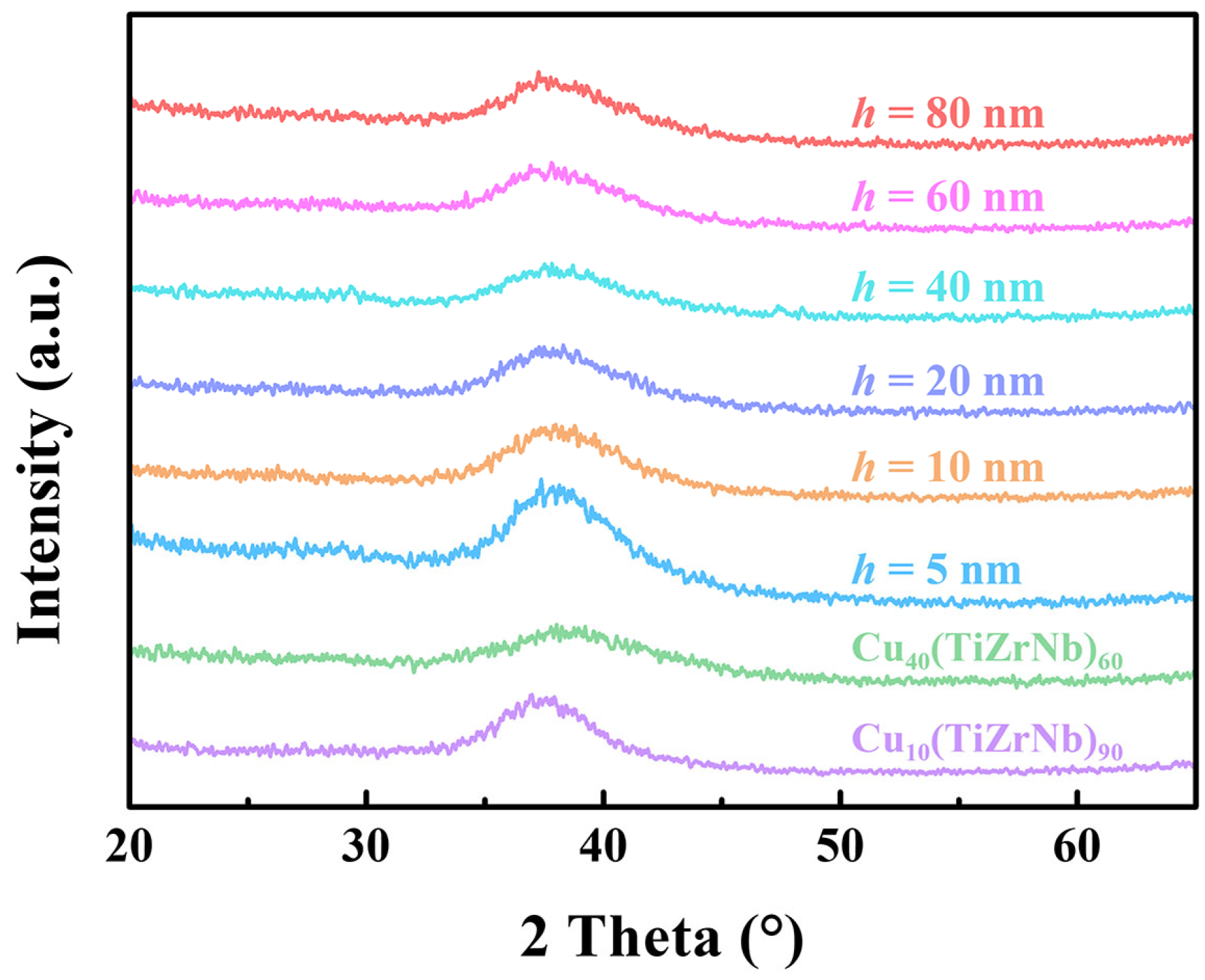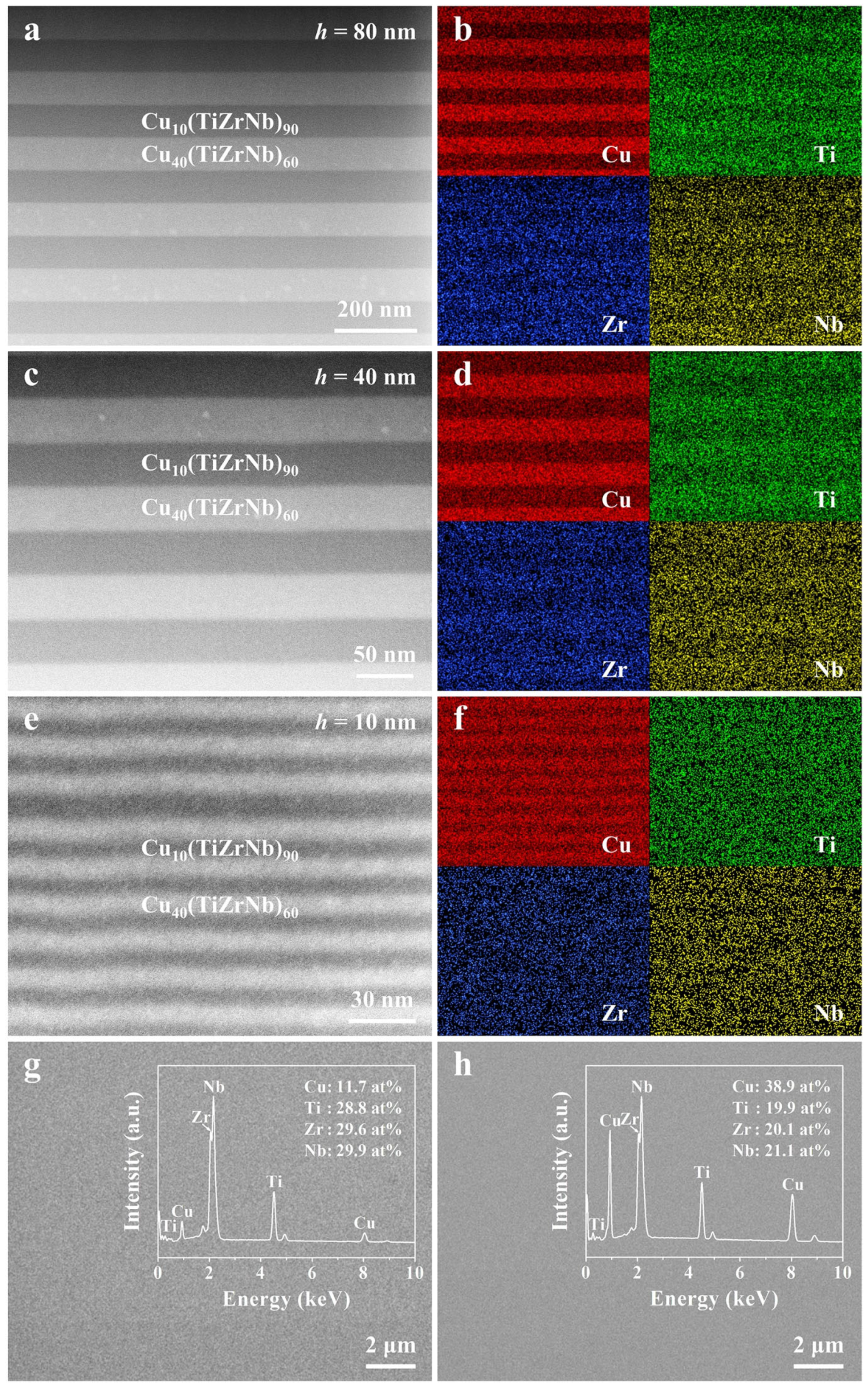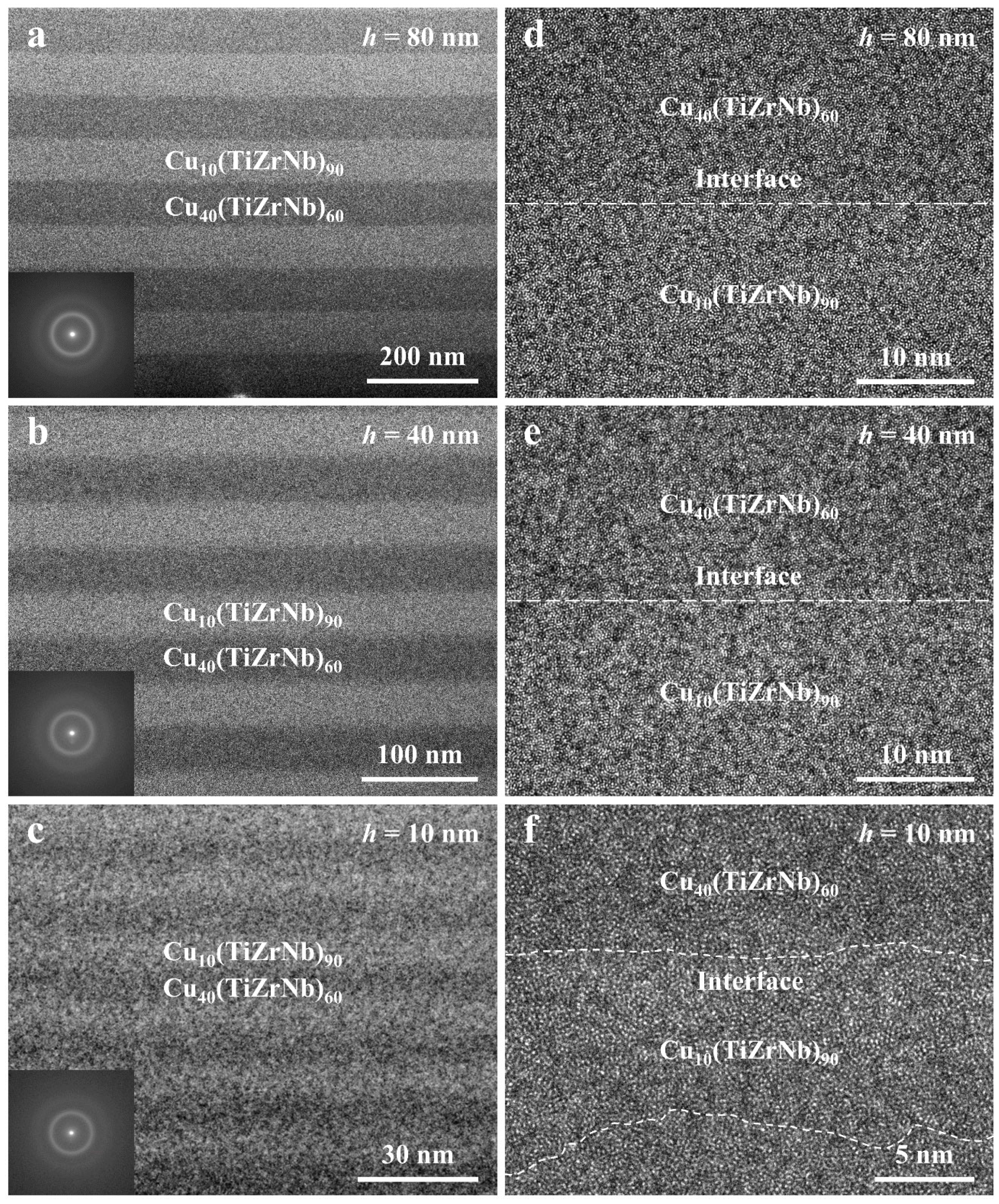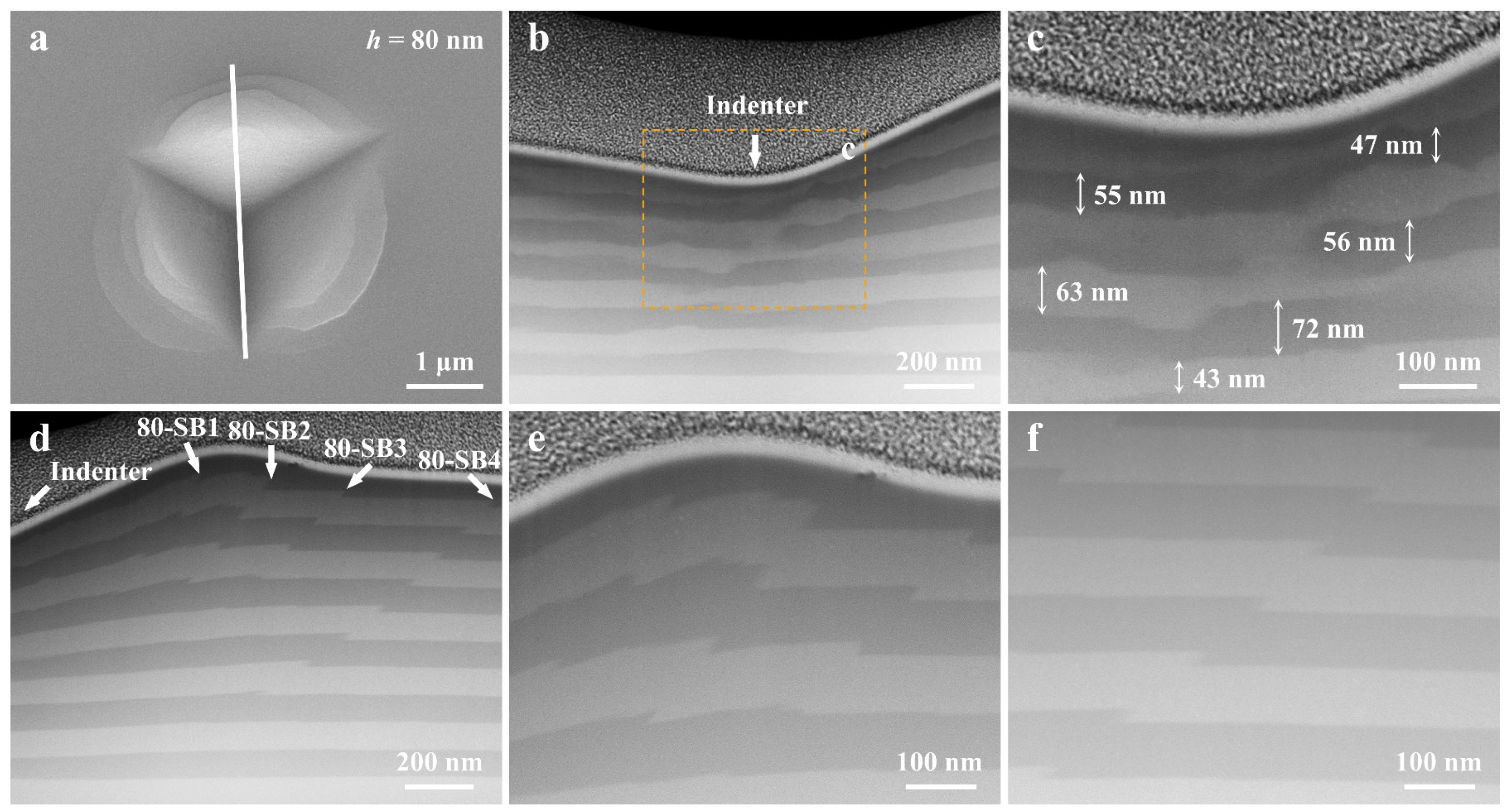Quantifying the Size-Dependent Shear Banding Behavior in High-Entropy Alloy-Based Nanolayered Glass
Abstract
:1. Introduction
2. Materials and Methods
3. Results and Discussion
3.1. Microstructures of the Cux(TiZrNb)100−x NLGs
3.2. Mechanical Behaviors of the Cux(TiZrNb)100−x NLGs
3.2.1. The Hardness of the Cux(TiZrNb)100−x NLGs
3.2.2. The Shear Instability of the Cux(TiZrNb)100−x NLGs
4. Conclusions
- (1)
- The hardness and elastic modulus of the Cux(TiZrNb)100−x NLGs are not sensitive to changes in the layer thickness. Specifically, in the range of h = 5–80 nm, the values of hardness and elastic modulus of the six samples fluctuate within the ranges of 6.79–6.95 GPa and 122.67–127.52 GPa, respectively.
- (2)
- The deformation behaviors of the Cux(TiZrNb)100−x NLGs in the areas underneath the indenter change with the decrease of layer thickness. In the areas underneath the indenter, the sample with h = 80 nm is deformed by the uneven thinning of the constituent layers, while the deformation of the samples with h = 40 and 10 nm is accommodated by multiple SBs.
- (3)
- In the areas near the indenter, the formed SBs are all cutting-like SBs for the Cux(TiZrNb)100−x NLG with h = 80 nm, a combination of the cutting-like and kinking-like SBs is observed for the sample with h = 40 nm, and the kinking-like primary SBs and many secondary SBs are appeared in the sample with h = 10 nm.
- (4)
- The resistance to shear instability of the Cux(TiZrNb)100−x NLGs increases monotonically with the decrease of layer thickness. When h decreases from 80 to 10 nm, the ξp,max values of the samples decrease from 5.94 to 4.29. The improvement in shear instability resistance comes from the increase in the number of A/A interfaces and the A/A interfaces becoming wavier, which can effectively block the propagation of SBs.
Author Contributions
Funding
Data Availability Statement
Conflicts of Interest
References
- Trexler, M.M.; Thadhani, N.N. Mechanical properties of bulk metallic glasses. Prog. Mater. Sci. 2010, 55, 759–839. [Google Scholar] [CrossRef]
- Cheng, Y.; Ma, E. Atomic-level structure and structure–property relationship in metallic glasses. Prog. Mater. Sci. 2011, 56, 379–473. [Google Scholar] [CrossRef]
- Yang, Y.; Zhou, J.; Zhu, F.; Yuan, Y.; Chang, D.J.; Kim, D.S.; Pham, M.; Rana, A.; Tian, X.; Yao, Y. Determining the three-dimensional atomic structure of an amorphous solid. Nature 2021, 592, 60–64. [Google Scholar] [CrossRef] [PubMed]
- Ashby, M.; Greer, A.L. Metallic glasses as structural materials. Scripta Mater. 2006, 54, 321–326. [Google Scholar] [CrossRef]
- Meyers, M.A.; Mishra, A.; Benson, D.J. Mechanical properties of nanocrystalline materials. Prog. Mater. Sci. 2006, 51, 427–556. [Google Scholar] [CrossRef]
- Nguyen, T.A.K.; Dang, N.M.; Lin, C.-H.; Lee, M.-C.; Wang, Z.-Y.; Tsai, Y.-C.; Lin, M.-T. Effects of RF magnetron sputtering power on the mechanical behavior of Zr-Cu-based metallic glass thin films. Nanomaterials 2023, 13, 2677. [Google Scholar] [CrossRef]
- Wang, W.-H.; Dong, C.; Shek, C. Bulk metallic glasses. Mater. Sci. Eng. R 2004, 44, 45–89. [Google Scholar] [CrossRef]
- Schuh, C.A.; Hufnagel, T.C.; Ramamurty, U. Mechanical behavior of amorphous alloys. Acta Mater. 2007, 55, 4067–4109. [Google Scholar] [CrossRef]
- Greer, A.; Cheng, Y.; Ma, E. Shear bands in metallic glasses. Mater. Sci. Eng. R 2013, 74, 71–132. [Google Scholar] [CrossRef]
- Chen, D.; Dong, J.-F.; Ma, G.-Z. Synthesis and compressive fracture behavior of a CuZr-based bulk amorphous alloy with Ti addition. J. Cent. S. Univ. 2013, 20, 1137–1141. [Google Scholar] [CrossRef]
- Wang, Z.T.; Pan, J.; Li, Y.; Schuh, C.A. Densification and strain hardening of a metallic glass under tension at room temperature. Phys. Rev. Lett. 2013, 111, 135504. [Google Scholar] [CrossRef]
- Jang, D.; Greer, J.R. Transition from a strong-yet-brittle to a stronger-and-ductile state by size reduction of metallic glasses. Nat. Mater. 2010, 9, 215–219. [Google Scholar] [CrossRef]
- Qiao, J.; Jia, H.; Liaw, P.K. Metallic glass matrix composites. Mater. Sci. Eng. R 2016, 100, 1–69. [Google Scholar] [CrossRef]
- Qin, F.; Dai, K.; Chen, S.; Li, J. Nickel content-dependent microstructure and mechanical properties of TiZrNbHfNi high entropy alloy thin films. Mater. Today Commun. 2024, 38, 107932. [Google Scholar] [CrossRef]
- Katnagallu, S.; Wu, G.; Singh, S.P.; Nandam, S.H.; Xia, W.; Stephenson, L.T.; Gleiter, H.; Schwaiger, R.; Hahn, H.; Herbig, M. Nanoglass–nanocrystal composite—A novel material class for enhanced strength–plasticity synergy. Small 2020, 16, 2004400. [Google Scholar] [CrossRef]
- Gleiter, H. Nanoglasses: A new kind of noncrystalline material and the way to an age of new technologies? Small 2016, 12, 2225–2233. [Google Scholar] [CrossRef]
- Wang, Y.M.; Li, J.; Hamza, A.V.; Barbee, T.W. Ductile crystalline-amorphous nanolaminates. Proc. Natl. Acad. Sci. USA 2007, 104, 11155–11160. [Google Scholar] [CrossRef]
- Wang, Y.; Gleiter, H.; Li, M. From patterning heterogeneity to nanoglass: A new approach to harden and toughen metallic glasses. MRS Bull. 2023, 48, 56–67. [Google Scholar] [CrossRef]
- Huang, Y.; Qin, F.; Dai, K.; Chen, S.; Li, J.; Li, J. Substantial toughening by thick nanoscale amorphous intergranular films in nanocrystalline materials. J. Appl. Phys. 2023, 134, 235101. [Google Scholar] [CrossRef]
- Wang, Y.; Li, J.; Li, J.; Chen, S. On the strain delocalization mechanism of Cu/Nb nanolayered composites with amorphous interfacial layers. Int. J. Plast. 2024, 172, 103856. [Google Scholar] [CrossRef]
- Qin, F.; Chen, F.; Hou, J.; Lu, W.; Chen, S.; Li, J. Strong resistance to shear instability in multilayered metallic composites by nanoscale amorphous-BCC crystalline interfaces. Mater. Sci. Eng. A 2024, 891, 145919. [Google Scholar] [CrossRef]
- Kou, H.; Lu, J.; Li, Y. High-strength and high-ductility nanostructured and amorphous metallic materials. Adv. Mater. 2014, 26, 5518–5524. [Google Scholar] [CrossRef]
- Sha, Z.D.; He, L.C.; Pei, Q.X.; Liu, Z.S.; Zhang, Y.W.; Wang, T.J. The mechanical properties of a nanoglass/metallic glass/nanoglass sandwich structure. Scripta Mater. 2014, 83, 37–40. [Google Scholar] [CrossRef]
- Wang, H.; Chen, D.; An, X.; Zhang, Y.; Sun, S.; Tian, Y.; Zhang, Z.; Wang, A.; Liu, J.; Song, M. Deformation-induced crystalline-to-amorphous phase transformation in a CrMnFeCoNi high-entropy alloy. Sci. Adv. 2021, 7, eabe3105. [Google Scholar] [CrossRef]
- Hofmann, D.C.; Suh, J.-Y.; Wiest, A.; Duan, G.; Lind, M.-L.; Demetriou, M.D.; Johnson, W.L. Designing metallic glass matrix composites with high toughness and tensile ductility. Nature 2008, 451, 1085–1089. [Google Scholar] [CrossRef]
- Li, J.; Chen, H.; Feng, H.; Fang, Q.; Liu, Y.; Liu, F.; Wu, H.; Liaw, P.K. Microstructure evolution and deformation mechanism of amorphous/crystalline high-entropy-alloy composites. J. Mater. Sci. Technol. 2020, 54, 14–19. [Google Scholar] [CrossRef]
- Liu, M.C.; Du, X.H.; Lin, I.C.; Pei, H.J.; Huang, J.C. Superplastic-like deformation in metallic amorphous/crystalline nanolayered micropillars. Intermetallics 2012, 30, 30–34. [Google Scholar] [CrossRef]
- Luo, J.; Sun, W.; Liang, D.; Chan, K.C.; Yang, X.-S.; Ren, F. Superior wear resistance in a TaMoNb compositionally complex alloy film via in-situ formation of the amorphous-crystalline nanocomposite layer and gradient nanostructure. Acta Mater. 2023, 243, 118503. [Google Scholar] [CrossRef]
- Pei, H.J.; Kuan, S.Y.; Liu, M.C.; Huang, J.C. Tensile behavior of amorphous/nanocrystalline ZrCu/Cu multilayered films with graded interfaces. Intermetallics 2012, 31, 191–195. [Google Scholar] [CrossRef]
- Phan, T.; Rigelesaiyin, J.; Chen, Y.; Bastawros, A.; Xiong, L. Metallic glass instability induced by the continuous dislocation absorption at an amorphous/crystalline interface. Acta Mater. 2020, 189, 10–24. [Google Scholar] [CrossRef]
- Yan, Z.; Liu, Z.; Yao, B.; An, Q.; Zhang, R.; Zheng, S. Effect of amorphous complexions on plastic deformation of nanolayered composites. Scripta Mater. 2023, 231, 115470. [Google Scholar] [CrossRef]
- Zhang, J.Y.; Liu, G.; Sun, J. Self-toughening crystalline Cu/amorphous Cu-Zr nanolaminates: Deformation-induced devitrification. Acta Mater. 2014, 66, 22–31. [Google Scholar] [CrossRef]
- Zhao, Y.F.; Chen, B.; Wang, Y.Q.; Zhang, J.Y.; Li, S.Z.; Wu, K.; Liu, G.; Sun, J. Size-dependent microstructural evolution and mechanical properties of crystalline/amorphous high-entropy alloy nanostructured multilayers: Cu/FeCoCrNiBSi vs Ni/FeCoCrNiBSi. Acta Mater. 2023, 246, 118706. [Google Scholar] [CrossRef]
- Brandl, C.; Germann, T.C.; Misra, A. Structure and shear deformation of metallic crystalline–amorphous interfaces. Acta Mater. 2013, 61, 3600–3611. [Google Scholar] [CrossRef]
- Wu, Y.; Xiao, Y.; Chen, G.; Liu, C.T.; Lu, Z. Bulk metallic glass composites with transformation-mediated work-hardening and ductility. Adv. Mater. 2010, 22, 2770–2773. [Google Scholar] [CrossRef]
- Wu, G.; Chan, K.-C.; Zhu, L.; Sun, L.; Lu, J. Dual-phase nanostructuring as a route to high-strength magnesium alloys. Nature 2017, 545, 80–83. [Google Scholar] [CrossRef]
- Wu, G.; Liu, C.; Sun, L.; Wang, Q.; Sun, B.; Han, B.; Kai, J.-J.; Luan, J.; Liu, C.T.; Cao, K. Hierarchical nanostructured aluminum alloy with ultrahigh strength and large plasticity. Nat. Commun. 2019, 10, 5099. [Google Scholar] [CrossRef]
- Wu, G.; Balachandran, S.; Gault, B.; Xia, W.; Liu, C.; Rao, Z.; Wei, Y.; Liu, S.; Lu, J.; Herbig, M.; et al. Crystal–glass high-entropy nanocomposites with near theoretical compressive strength and large deformability. Adv. Mater. 2020, 32, 2002619. [Google Scholar] [CrossRef]
- Sharma, A.; Nandam, S.H.; Hahn, H.; Prasad, K.E. On the differences in shear band characteristics between a binary Pd-Si metallic and nanoglass. Scripta Mater. 2021, 191, 17–22. [Google Scholar] [CrossRef]
- Sharma, A.; Hirmukhe, S.S.; Nandam, S.H.; Hahn, H.; Singh, I.; Narayan, R.L.; Prasad, K.E. Strain rate sensitivity of a Cu60Zr40 metallic and nanoglass. J. Alloys Compd. 2022, 921, 165991. [Google Scholar] [CrossRef]
- Sha, Z.; Branicio, P.; Pei, Q.; Liu, Z.; Lee, H.; Tay, T.; Wang, T. Strong and superplastic nanoglass. Nanoscale 2015, 7, 17404–17409. [Google Scholar] [CrossRef]
- Pan, J.; Ivanov, Y.P.; Zhou, W.H.; Li, Y.; Greer, A.L. Strain-hardening and suppression of shear-banding in rejuvenated bulk metallic glass. Nature 2020, 578, 559–562. [Google Scholar] [CrossRef]
- Nandam, S.H.; Ivanisenko, Y.; Schwaiger, R.; Śniadecki, Z.; Mu, X.; Wang, D.; Chellali, R.; Boll, T.; Kilmametov, A.; Bergfeldt, T.; et al. Cu-Zr nanoglasses: Atomic structure, thermal stability and indentation properties. Acta Mater. 2017, 136, 181–189. [Google Scholar] [CrossRef]
- Sharma, P.; Yubuta, K.; Kimura, H.; Inoue, A. Brittle metallic glass deforms plastically at room temperature in glassy multilayers. Phys. Rev. B 2009, 80, 024106. [Google Scholar] [CrossRef]
- Voigt, H.; Rigoni, A.; Boltynjuk, E.; Chellali, M.R.; Tyler, B.; Rösner, H.; Divinski, S.; Hahn, H.; Wilde, G. Evidence for glass–glass interfaces in a columnar Cu–Zr nanoglass. Adv. Funct. Mater. 2023, 33, 2302386. [Google Scholar] [CrossRef]
- Wang, X.; Jiang, F.; Hahn, H.; Li, J.; Gleiter, H.; Sun, J.; Fang, J. Sample size effects on strength and deformation mechanism of Sc75Fe25 nanoglass and metallic glass. Scripta Mater. 2016, 116, 95–99. [Google Scholar] [CrossRef]
- Adibi, S.; Sha, Z.-D.; Branicio, P.S.; Joshi, S.P.; Liu, Z.-S.; Zhang, Y.-W. A transition from localized shear banding to homogeneous superplastic flow in nanoglass. Appl. Phys. Lett. 2013, 103, 211905. [Google Scholar] [CrossRef]
- Wang, X.L.; Jiang, F.; Hahn, H.; Li, J.; Gleiter, H.; Sun, J.; Fang, J.X. Plasticity of a scandium-based nanoglass. Scripta Mater. 2015, 98, 40–43. [Google Scholar] [CrossRef]
- Zhao, Y.; Peng, X.; Huang, C.; Yang, B.; Hu, N.; Wang, M. Super ductility of nanoglass aluminium nitride. Nanomaterials 2019, 9, 1535. [Google Scholar] [CrossRef]
- Doan, D.-Q.; Fang, T.-H.; Tran, T.-B.-T. Deformation behavior and strengthening mechanism of CuTa/CuTa amorphous/amorphous nanomultilayers. J. Non-Cryst. Solids 2023, 600, 121993. [Google Scholar] [CrossRef]
- Huang, L.; Huang, P.; Wang, F. Excellent work-hardening in ZrCu/NiNb amorphous/amorphous nanolaminates. Mater. Sci. Eng. A 2022, 831, 142277. [Google Scholar] [CrossRef]
- Huang, L.; Huang, P.; Wang, F. A new deformation mechanism of amorphous/amorphous laminates at deep nanoscale. Mater. Sci. Eng. A 2021, 809, 140923. [Google Scholar] [CrossRef]
- Wu, G.; Liu, S.; Wang, Q.; Rao, J.; Xia, W.; Yan, Y.-Q.; Eckert, J.; Liu, C.; Ma, E.; Shan, Z.-W. Substantially enhanced homogeneous plastic flow in hierarchically nanodomained amorphous alloys. Nat. Commun. 2023, 14, 3670. [Google Scholar] [CrossRef]
- Zhou, X.; Chen, C. Strengthening and toughening mechanisms of amorphous/amorphous nanolaminates. Int. J. Plast. 2016, 80, 75–85. [Google Scholar] [CrossRef]
- Chen, Z.Q.; Li, M.C.; Cao, J.S.; Li, F.C.; Guo, S.W.; Sun, B.A.; Ke, H.B.; Wang, W.H. Interface dominated deformation transition from inhomogeneous to apparent homogeneous mode in amorphous/amorphous nanolaminates. J. Mater. Sci. Technol. 2022, 99, 178–183. [Google Scholar] [CrossRef]
- Fan, Z.; Xue, S.; Wang, J.; Yu, K.Y.; Wang, H.; Zhang, X. Unusual size dependent strengthening mechanisms of Cu/amorphous CuNb multilayers. Acta Mater. 2016, 120, 327–336. [Google Scholar] [CrossRef]
- Oliver, W.C.; Pharr, G.M.J. An improved technique for determining hardness and elastic modulus using load and displacement sensing indentation. J. Mater. Res. 1992, 7, 1564–1583. [Google Scholar] [CrossRef]
- Bull, S.J.; Chen, J. Relation between the ratio of elastic work to the total work of indentation and the ratio of hardness to Young’s modulus for a perfect conical tip. J. Mater. Res. 2009, 24, 590–598. [Google Scholar]
- Chen, J.; Bull, S.J.; Roy, S.; Kapoor, A.; Mukaibo, H.; Nara, H.; Momma, T.; Osaka, T.; Shacham-Diamand, Y. Nanoindentation and nanowear study of Sn and Ni–Sn coatings. Tribol. Int. 2009, 42, 779–791. [Google Scholar] [CrossRef]
- Xu, Y.-K.; Ma, H.; Xu, J.; Ma, E. Mg-based bulk metallic glass composites with plasticity and gigapascal strength. Acta Mater. 2005, 53, 1857–1866. [Google Scholar] [CrossRef]
- Li, Y.P.; Zhu, X.F.; Tan, J.; Wu, B.; Zhang, G.P. Two different types of shear-deformation behaviour in Au–Cu multilayers. Philos. Mag. Lett. 2009, 89, 66–74. [Google Scholar] [CrossRef]
- Gunti, A.; Jana, P.P.; Lee, M.-H.; Das, J. Effect of cold rolling on the evolution of shear bands and nanoindentation hardness in Zr41.2Ti13.8Cu12.5Ni10Be22.5 bulk metallic glass. Nanomaterials 2021, 11, 1670. [Google Scholar] [CrossRef] [PubMed]
- Demetriou, M.D.; Launey, M.E.; Garrett, G.; Schramm, J.P.; Hofmann, D.C.; Johnson, W.L.; Ritchie, R.O. A damage-tolerant glass. Nat. Mater. 2011, 10, 123–128. [Google Scholar] [CrossRef] [PubMed]
- Guan, Y.; Wang, Y.; Song, W. Modulating mechanical performances of metallic amorphous materials through phase gradient. Int. J. Mech. Sci. 2022, 234, 107680. [Google Scholar] [CrossRef]
- Delogu, F. Identification and characterization of potential shear transformation zones in metallic glasses. Phys. Rev. Lett. 2008, 100, 255901. [Google Scholar] [CrossRef]
- Kuan, S.Y.; Chou, H.S.; Liu, M.C.; Du, X.H.; Huang, J.C. Micromechanical response for the amorphous/amorphous nanolaminates. Intermetallics 2010, 18, 2453–2457. [Google Scholar] [CrossRef]











| SB | α (o) | wSB (nm) | hp (nm) |
|---|---|---|---|
| 80-SB1 | 58 | 21 | 101 |
| 80-SB2 | 51 | 16 | 95 |
| 80-SB3 | 46 | 13 | 51 |
| 80-SB4 | 41 | 10 | 21 |
| 40-SB1 | 67 | 13 | 49 |
| 40-SB2 | 47 | 18 | 67 |
| 40-SB3 | 40 | 8 | 38 |
| 10-SB1 | 48 | 17 | 73 |
| 10-SB2 | 44 | 12 | 30 |
| 10-SB3 | 46 | 9 | 8 |
Disclaimer/Publisher’s Note: The statements, opinions and data contained in all publications are solely those of the individual author(s) and contributor(s) and not of MDPI and/or the editor(s). MDPI and/or the editor(s) disclaim responsibility for any injury to people or property resulting from any ideas, methods, instructions or products referred to in the content. |
© 2024 by the authors. Licensee MDPI, Basel, Switzerland. This article is an open access article distributed under the terms and conditions of the Creative Commons Attribution (CC BY) license (https://creativecommons.org/licenses/by/4.0/).
Share and Cite
Dai, K.; Zhang, C.; Lu, W.; Li, J. Quantifying the Size-Dependent Shear Banding Behavior in High-Entropy Alloy-Based Nanolayered Glass. Nanomaterials 2024, 14, 546. https://doi.org/10.3390/nano14060546
Dai K, Zhang C, Lu W, Li J. Quantifying the Size-Dependent Shear Banding Behavior in High-Entropy Alloy-Based Nanolayered Glass. Nanomaterials. 2024; 14(6):546. https://doi.org/10.3390/nano14060546
Chicago/Turabian StyleDai, Kaiqing, Chun Zhang, Wenjun Lu, and Jianjun Li. 2024. "Quantifying the Size-Dependent Shear Banding Behavior in High-Entropy Alloy-Based Nanolayered Glass" Nanomaterials 14, no. 6: 546. https://doi.org/10.3390/nano14060546





